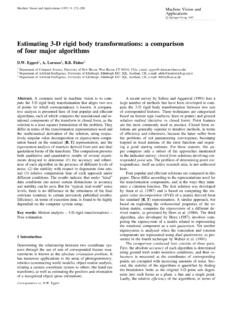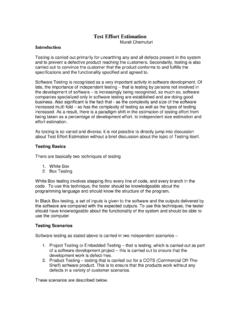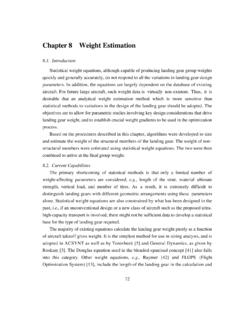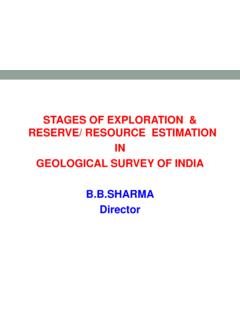Transcription of A Comparison of Estimation Methods for Vector ...
1 A Comparison of Estimation Methods for Vector AutoregressiveMoving-Average Models Christian Kascha Norges Bank, University of ZurichDecember 23, 2010 AbstractRecently, there has been a renewed interest in modeling economic time series by vectorautoregressive moving-average models. However, this class of models has been unpopularin practice because of Estimation problems and the complexity of the identification disadvantages could have led to the dominant use of Vector autoregressive modelsin macroeconomic research. In this paper, several simple Estimation Methods for vectorautoregressive moving-average models are compared among each other and with purevector autoregressive modeling using ordinary least squares by means of a Monte Carlostudy. Different evaluation criteria are used to judge the relative performances of classi cation: C32, C15, C63 Keywords: VARMA Models, Estimation Algorithms, Forecasting I thank Helmut L utkepohl and Anindya Banerjee for helpful comments and discussion.
2 I also thank twoanonymous referees for comments and suggestions that considerably improved the paper. The research for thispaper was done at the European University Institute, Florence. The views expressed in this paper are my ownand do not necessarily reflect the views of Norges : Christian Kascha, University of Zurich, Department of Economics, Zurichbergstrasse 14, 8032 Zurich, Switzerland. Phone: +41 44 634 23 01. Fax: +41 44 634 49 96. IntroductionAlthough Vector autoregressive moving-average (VARMA) models have theoretical advantagescompared to simpler Vector autoregressive (VAR) models, VARMA models are rarely used inapplied macroeconomic work. The likely reasons are Estimation problems and, in particular,the complexity of the identification stage. This paper investigates the relative performance ofseveral simple Estimation Methods for VARMA models that have not been compared system-atically by means of a Monte Carlo study.
3 The Methods are also compared with maximumlikelihood Estimation and pure Vector autoregressive modeling using ordinary least evaluation criteria are the accuracy of the parameter estimates, the accuracy of pointforecasts as well as the precision of the estimated impulse responses. I focus on sample lengthsand processes that could be considered typical for macroeconomic problem of estimating VARMA models received considerable attention for severalreasons. Linear models such as VARs or univariate autoregressive moving-average (ARMA)models have proved to be simple and analytically tractable, while capable of reproducingcomplex dynamics. Linear forecasts often appear to be more robust than nonlinear alterna-tives and their empirical usefulness has been documented in various studies ( Newbold &Granger 1974). A more recent example is the integrated moving-average model for US infla-tion of Stock & Watson (2007).
4 Therefore, VARMA models are of interest as generalizationsof successful univariate ARMA the class of multivariate linear models, pure VARs dominate in macroeconomic applica-tions. However, VAR models may require a rather large lag length in order to describe a series adequately . This means a loss of precision because many parameters have to be problem could be avoided by using VARMA models that may provide a more parsimo-nious description of the data generating process (DGP). In contrast to the class of VARMA models, the class of VAR models is not closed under linear transformations. For example, asubset of variables generated by a VAR process is typically generated by a VARMA, not by aVAR process (L utkepohl 1984a,b). The VARMA class includes many models of interest suchas unobserved component models. It is well known that linearized dynamic stochastic general2equilibrium (DSGE) models imply that the variables of interest are generated by a finite-orderVARMA process.
5 Fern andez-Villaverde, Rubio-Ram rez, Sargent & Watson (2007) show for-mally how DSGE models and VARMA processes are linked. Also Cooley & Dwyer (1998)claim that modeling macroeconomic time series systematically as pure VARs is not justifiedby the underlying economic theory. The recent debate between Chari, Kehoe & McGrattan(2008) and Christiano, Eichenbaum & Vigfusson (2006) on the ability of structural VARs touncover fundamental shocks also questions implicitly the ability of pure VARs to capture thedynamics of an economic , there are also some complications that make VARMA modeling more , VARMA representations are not unique. That is, there are typically many parameteri-zations that can describe the same DGP; see L utkepohl (2005). An identified representation,however, is needed for consistent Estimation . Therefore, a researcher has to choose first such arepresentation.
6 In any case, an identified VARMA representation has to be specified by moreinteger-valued parameters than a VAR representation that is determined just by one integerparameter, the lag length. This aspect introduces additional uncertainty at the specificationstage of the modeling process, although procedures for VARMA models do exist which couldbe used in a completely automatic way (Hannan & Kavalieris 1984b, Poskitt 1992). Apartfrom a more involved specification stage, the Estimation stage is also affected by the identi-fication problem because one usually has to examine many different models which turn outnot to be identified literature on the Estimation of VARMA models traditionally focussed on maximumlikelihood Methods which are asymptotically efficient ( Hillmer & Tiao 1979, Mauricio1995, Metaxoglou & Smith 2007). However, several simpler Estimation Methods have alsobeen proposed as computationally less intense and more robust alternatives to maximumlikelihood (see Durbin 1960, Hannan & Rissanen 1982, Hannan & Kavalieris 1984b,Koreisha & Pukkila 1990, Kapetanios 2003, Dufour & Pelletier 2008).
7 In addition, theycan serve to initialize maximum likelihood procedures and they can be used in a foregoingspecification , it is not clear which of these Methods is preferable under1 Recently, subspace algorithms for state space systems, an equivalent representation of a VARMA process,have become popular also among econometricians. Examples are the algorithms of Van Overschee & DeMoor3which circumstances. The available comparisons in the literature are relatively limited. Theabove cited papers include comparisons of some of the simple Estimation algorithms but eitherconsider only a limited number of algorithms or only one or two VARMA DGPs. Kapetanios(2003) considers a wide range of algorithms and DGPs but only considers one low-dimensionaland relatively well behaved VARMA contrast, this study focusses on simple algorithms and compares them using many dif-ferent DGPs.
8 The eigenvalues of both the autoregressive and the moving-average polynomialof a given VARMA process are varied in order to investigate the algorithms performancein favorable and difficult cases. This is important as the algorithms have to work well ina variety of situations because the underlying DGP is unknown in applications. Also, in-stead of focussing only on the accuracy of the parameter estimates, I consider the use of theestimated VARMA models. After all, a researcher might be rather interested in the accu-racy of the generated forecasts or the precision of the estimated impulse response functionthan in the actual parameter estimates. To the best of my knowledge, this is the only studyon VARMA Estimation that shares these features. I conduct Monte Carlo simulations forfour different DGPs with varying parameterizations. I consider the case when the orders ofthe true process are known and I focus on stationary processes.
9 Four different simple algo-rithms are used and compared among each other and with two benchmark VARs. They arebenchmarked against a full information maximum likelihood procedure starting from the trueparameter values. The algorithms are the Hannan-Rissanen procedure (Durbin 1960, Hannan& Rissanen 1982), the iterative least squares procedure of Kapetanios (2003), the generalizedleast squares procedure of Koreisha & Pukkila (1990) and the Hannan-Kavalieris algorithm(Hannan & Kavalieris 1984b). The obtained results suggest that the algorithm of Hannan &Kavalieris (1984b) is generally preferable to the other algorithms and the benchmark , the procedure is technically not very reliable in that the algorithm very often yieldsestimated models which are not stable or produces too many outliers for specific DGPs andparameterizations. Therefore, the algorithm would have to be improved in order to make itan alternative tool for applied researchers.
10 (1994) or Larimore (1983). See also the survey of Bauer (2005). A Comparison with these estimators is howeverbeyond the scope of the rest of the paper is organized as follows. In section 2, stationary VARMA processesare introduced and the Echelon parameterization is presented. In section 3, the differentestimation algorithms are described. The setup and the results of the Monte Carlo study arepresented in section 4. Section 5 concludes. All programs are written in GAUSS and can beobtained from the homepage of the Stationary VARMA ProcessesI consider linear, time-invariant, covariance - stationary processes (yt)t Zof dimensionKthatallow for a VARMA(p,q) representation of the formA0yt=A1yt 1+..+Apyt p+M0ut+M1ut 1+..+Mqut q,(1)fort Z, p, q N0. The matricesA0,A1,..,ApandM0,M1,..,Mqare of dimension(K K). The termutrepresents a white noise sequence of random variables with meanzero and nonsingular covariance matrix.









